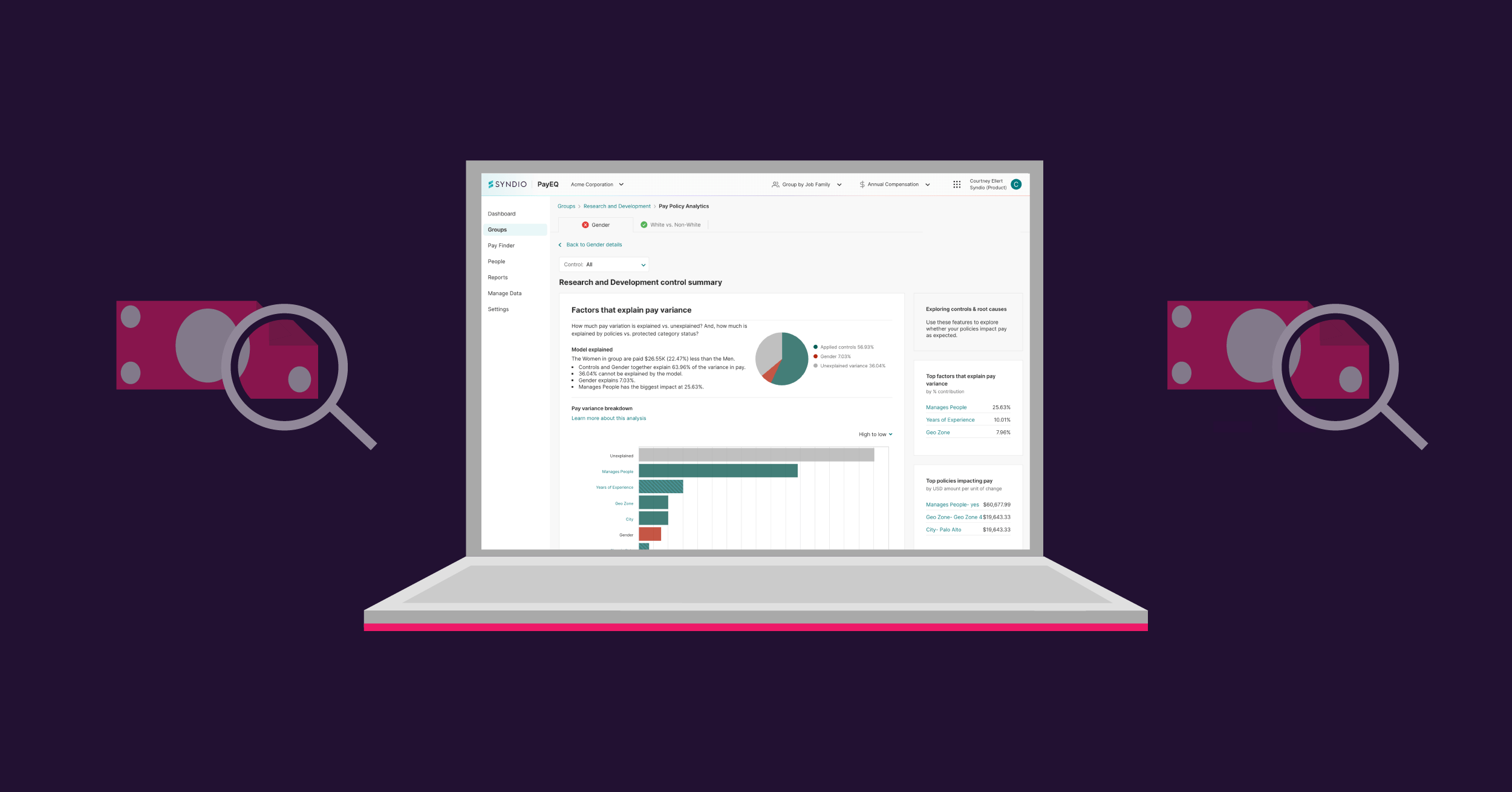Take two hypothetical employees: Jim and Kim. Jim and Kim are both Level 3 software engineers at the same technology company. Jim makes $178,000 a year. Kim makes $105,000. Why?
Most companies couldn’t answer that question. Until now.
Paying fairly and consistently is hard
There are a lot of factors — also known as pay policies — that go into determining employees’ salaries when their role and responsibilities are the same. Tenure, performance, location, education, and more.
The trouble is, many of these factors are subject to interpretation, introduce bias, or are not considered consistently during pay decisions. And therefore, the pay policies don’t always work as intended. The result could be unlawful pay inequities or unintentional pay differences that fail to motivate and reward the right behaviors.
That’s normal. Policies don’t always work perfectly in practice. But what’s the fix?
The missing ingredient is insight. Most companies have zero visibility into what’s happening in practice. They put policies in place and cross their fingers that they are having the desired effects on compensation. But if you can’t measure and track your pay policies, you have no way to validate that they’re working or take action if they’re not.
Designing or optimizing pay policies? Read our “Guide on Fair Pay Policies”
Today’s launch of Pay Policy Analytics addresses this challenge head on. Our advanced software gives organizations a precise, comprehensive, and current view into what’s driving differences in pay.
Here’s how it works.
Pay Policy Analytics software — holding up a mirror to compensation
Pay Policy Analytics, an extension of Syndio’s flagship product PayEQ®, holds up a mirror to pay policies to see if they’re working as intended, or if other factors — including gender, race, or ethnicity — are driving differences in pay. This helps you explain and improve pay policies and eradicate unlawful inequities.
Let’s go back to Jim and Kim and look at their group.
If the only reason Jim makes $73K more than Kim is because he’s male and she’s female, and we can show this difference to be statistically significant across all Level 3 Software engineers, then that’s gender discrimination and must be fixed.
Syndio’s Pay Policy Analytics software makes this easy to see by first identifying how much differences in compensation are due to gender or race, and then letting you drill into each pay policy to pinpoint — and ultimately resolve — pay inequity at the policy level.
For example, for Kim and Jim’s group, Pay Policy Analytics identifies the percentage of pay differences that are directly due to gender, as well as the dollar amount that males vs. females earn:
- based on their gender
- for every year of tenure
- for a PhD
- for the same performance score
- And so on
The comprehensive, precise analysis helps you pinpoint exactly where inequity is happening and why. And you can use these features to analyze any group and pay policy for any protected class, whether it’s gender, race, or ethnicity.
Fairness is more than gender and racial equity
But what if we rule out gender and race? Why exactly does Jim make more than Kim? Is his salary a reflection of his contributions? Is his salary helping to achieve specific hiring goals, like recruiting talent in locations with high cost of living? Again, most organizations can’t answer these questions.
Pay Policy Analytics can. With the click of a button, you can see which pay policies are impacting pay and by precisely how much.
For Jim and Kim, suppose Pay Policy Analytics reveals that Kim is paid less for the following reasons:
- Jim has a master’s degree (+ $10K); Kim has a BA (+ $5K).
- Jim has been with the company for 10 years (+ $24K); Kim has been there 5 years (+ $12K)
- Jim lives in San Francisco (+ $53K); Kim lives in Detroit (+ $0K)
The numbers add up to $73K — the exact difference in Jim and Kim’s compensation.
If pay differences map back to your company’s intentional pay policies, that’s great. But what if they don’t?
Pay Policy Analytics provides the insights to understand a whole range of factors so you can make changes if goals and intentions don’t align with practice, as in the examples below:
- Suppose the company wants to pay for performance. Jim always gets “meets expectations” while Kim consistently gets “exceeds expectations.” The above analysis reveals that performance is having no impact on compensation. Most employers — and employees — would say that’s unfair.
- What if paying for tenure is the goal to ensure employee stay with the company, but its relative impact is small, resulting in high employee churn?
- What if with Covid and a move to more remote work, location needs to have a much smaller impact on pay, or none at all, yet it’s one of the biggest drivers of differences in compensation?
(Always-on) knowledge is power
A one-time analysis and resolution doesn’t help you achieve pay policies that are fair, unbiased, and that consistently work as intended. To eliminate unfair pay differences, you need to consistently track pay policies and pay equity and make adjustments whenever you find inconsistencies. By making a commitment to analyzing, refining, and explaining pay policies in an ongoing manner, you can root out bias at the policy level, preventing inequity before it starts.
To see Syndio’s Pay Policy Analytics software in action, request a demo below.



